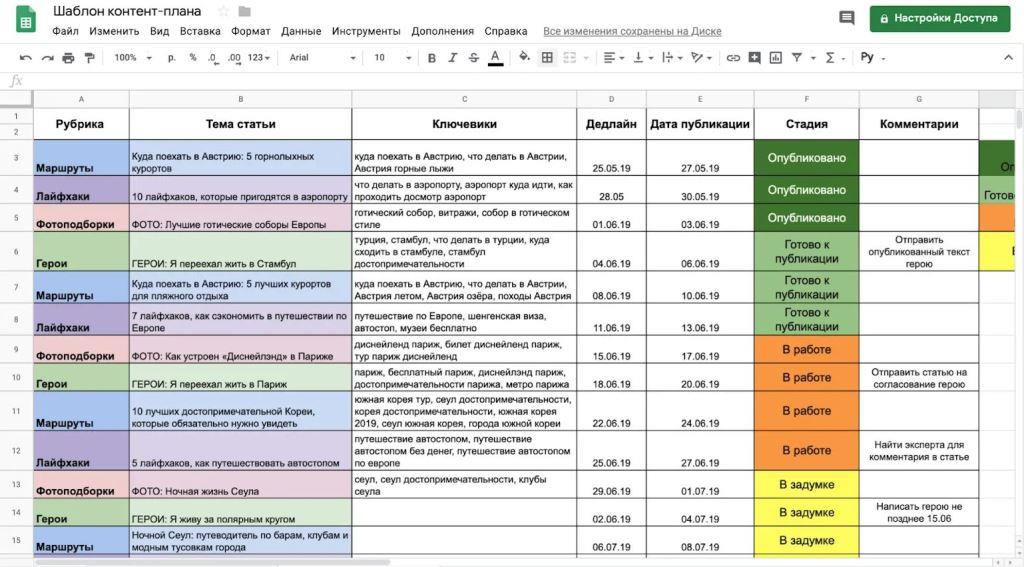Як створити контент-план для блогу чи соцмереж? Огляд кращих інструментів
Контент – це джерело інформації для користувачів в інтернеті і в той же час важливий інструмент для бізнесу. За допомогою правильної контент-стратегії просувають компанію, підвищують впізнаваність бренду, залучають клієнтів, доносять до них цінність продукту і в кінцевому підсумку спонукають придбати товар або замовити послугу. Витрати на контент-маркетинг зазвичай менше, ніж на рекламу. При цьому якість трафіку і відсоток конверсій, які він приносить, вище. Щоб отримати максимальну користь від контенту і досягти поставлених цілей, необхідно почати з планування.
Контент-план – це графік створення і розміщення публікацій компанії на певний період часу. Публікаціями можуть бути статті для блогів, пости в соцмережах, відео для YouTube, email-розсилки та інший контент. Місця розміщення публікацій вибирають виходячи з того, де сконцентрована цільова аудиторія.
Для чого потрібен контент-план?
Контент-план допомагає:
- упорядкувати процес створення і публікації контенту;
- окреслити цілі контенту які завдання бізнесу він повинен вирішувати;
- зафіксувати цікаві ідеї і вибрати актуальні теми;
- визначити деталі контенту: його вид, форма подачі, обсяг;
- розподілити завдання між виконавцями і контролювати робочий процес;
- робити послідовні публікації, досягаючи кінцевої мети.
Контент-план. приклад
Як створювати контент-план? Основні етапи
1. Визначити цілі контенту
Перш за все, необхідно відповісти на такі питання:
1) Які завдання бізнесу повинен вирішувати контент?
2) Хто цільова аудиторія?
Це дозволить зрозуміти, про що писати і для кого, знайти ідеї для майбутніх текстів та визначити майданчики, які відвідують потенційні клієнти, щоб поширювати там інформацію.
Якими можуть бути цілі контенту?
- підвищення довіри до бренду, PR;
- продажі;
- інші конверсії (підписка, запис на захід та інше);
- лояльність, перетворення нових клієнтів в постійних;
- відповіді на часті питання;
- інформування про новинки та спеціальні пропозиції;
- інші.
Портрет потенційного клієнта залежить від тематики бізнесу. У одного продукту може бути кілька цільових аудиторій. Щоб створити корисний контент, потрібно представляти, ким є споживач: регіон проживання, стать, вік, рід занять, інтереси, актуальні проблеми та інші корисні деталі.
2. Вивчити конкурентів
Це хороший спосіб зрозуміти, які матеріали по темі доступні в інтернеті зараз, наскільки вони інформативні, чого їм не вистачає, а також отримати більше ідей для свого контенту. Варто проаналізувати, які способи поширення використовують лідери ринку, що публікують в соцмережах і які питання висвітлюють у статтях.
Щоб знайти схожі сайти, роблять пошук по основним запитам. Також на спеціальних SEO-платформах можна знайти семантично близькі ресурси і провести аналіз конкурентів по кожному домену окремо: побачити ефективність тих чи інших сторінок, їх позиції в пошуку і приблизний трафік.
3. Визначити види контенту і місця розміщення
В якості засобів для поширення контенту використовують:
- розділ зі статтями на сайті компанії;
- тематичні ресурси, які відвідує цільова аудиторія;
- соцмережі (Facebook, Instagram і т.д.);
- email-розсилки;
- канал компанії на YouTube;
- інші.
Коли майданчики обрані, слід вирішити, який саме контент розміщувати. Якщо у компанії багато товарів або послуг, в корпоративному блозі може бути кілька рубрик. Тоді теми публікацій поділяють по групах. Також можуть відрізнятися види статей: загальна інформація про продукт, інструкції, порівняльні огляди, приклади та кейси, PR-тексти та інше.
Постинг в соцмережах (SMM) зазвичай має на увазі поєднання інформаційних, що продають, розважальних публікацій. Відповідні деталі заносять в контент-план.
4. Зібрати статистику пошукових запитів
Щоб контент був корисним, він повинен відповідати на питання цільової аудиторії. Аналіз пошукових запитів дає розуміння, про що запитують користувачі в конкретній ніші, як часто роблять ті чи інші звернення і які ІНТЕНТ (наміри) за цим стоять.
Також використання популярних запитів в якості ключових слів збільшує видимість текстів при ранжируванні і допомагає користувачам знаходити їх в пошуку.
5. Створити контент-план для кожної площадки
Якщо контент-стратегія орієнтована на кілька каналів маркетингу, тип публікацій і графік їх виходу будуть відрізнятися, а над їх створенням може працювати команда фахівців: копірайтери, SMM-щики, дизайнери, email-маркетологи.
Щоб працювати більш системно і продуктивно, для кожного каналу просування зроблять окремий контент-план. Нижче наведена приблизна структура контент-плану для статей і соцмереж.
Контент-план для статей
- список тем;
- вимоги до текстів: стилістика, обсяг, ключові слова і т.д .;
- ім’я копірайтера;
- термін написання;
- дата публікації.
Приклад:
 Контент-план є основним для подальшого написання вимог до статей (технічних завдань), яким будуть слідувати копірайтери при написанні.
Контент-план є основним для подальшого написання вимог до статей (технічних завдань), яким будуть слідувати копірайтери при написанні.
Контент-план для SMM
- тип поста: інформаційний, який продає, розважальний;
- тема публікації – про що буде пост;
- дата і час виходу.
Огляд інструментів для створення контент-плану
По суті контент-план являє собою таблицю з інформацією про майбутні публікації і графік їх виходу. Є сервіси для планування та розміщення контенту, які допомагають упорядкувати роботу і заощадити час.
Серед інструментів для планування є безкоштовні варіанти або ті, які пропонують ознайомитися з можливостями платних тарифів в тестовому режимі. Цінова політика і акції сервісів постійно оновлюються, тому тут будуть наведені розцінки, актуальні на сьогодні.
Таблиці та календарі
- Таблиці Exсel.
Вартість: безкоштовно.
Найпростіший спосіб створити шаблон контент-плану на будь-якому пристрої, незалежно від доступу до інтернету. Все, що потрібно додати колонки, заповнити їх, виділити кольором для зручності. Щоб таблицю могли бачити і редагувати інші користувачі, її завантажують в Google Таблиці та відкривають права доступу за посиланням на документ.
- Сервіси Google.
Вартість: безкоштовно.
- Google Таблиці.
За функціоналом такі таблиці схожі на Exсel. Перевагою є можливість спільної роботи, читання і редагування таблиці в режимі онлайн, об’єднання даних різних таблиць в одну, додавання зображень.
- Google Календар.
За допомогою календаря можна планувати публікації, налаштовувати нагадування у вигляді email або SMS, запрошувати інших учасників, фільтрувати заплановані події за часовими періодами.
Вартість: базовий тариф безкоштовно; два інших в залежності від опцій: 9,99 $ і 20,83 $ в місяць при оплаті за рік.
Перевагою сервісу є дизайн з візуалізацією завдань і додаткові інструменти: стікера з можливістю переміщення по робочій зоні; зберігання виконаних завдань в архіві; додавання в план міток і картинок; готові шаблони для різних типів контенту; чек-лист для перевірки виконаних завдань. Також Trello можна синхронізувати з іншими сервісами.
Вартість: базовий тариф безкоштовно; також доступні версії Premium (10,99 $), Business (24,99 $) і Enterprise (індивідуальний розрахунок ціни).
Ця програма для спільного управління проектами. У ньому запропоновано маркетингові шаблони для планування контенту, куди можна додавати теми публікацій в якості завдань і вибирати виконавців.
Вартість: є безкоштовна версія (Basic) з основним набором функцій, пакет Premium 65 грн в місяць і Business 279 грн в місяць.
Додаток для контент-плану, управління завданнями, створення списків справ і професійних цілей, інтеграція з іншими сервісами, додавання заміток у вигляді тексту / зображень / аудіофайлів, підтримка документів різного формату, командна робота.
Інструменти для SMM
Програми та сервіси для створення розкладу, включаючи автоматичну публікацію постів у соціальних мережах, дають можливість керувати кількома сторінками одночасно.
Вартість: діапазон цін на тарифи від 450 до 7500 рублів, залежно від кількості сторінок. Є безкоштовний 7-денний період.
Єдина панель управління різними соцмережами і мессенджерами без обмежень в кількість акаунтів. Публікації можна розміщувати і видаляти за розкладом.
- Amplifr.
Вартість: в залежності від розміру команди і кількості сторінок в соцмережах є кілька пакетів S, M, L, XL. Ціна стартує від 15 $ на місяць зі знижкою при оплаті за півроку або рік. Також є пробний період на 7 днів.
Сервіс пропонує наочний календар, де видно заплановані і розміщені публікації, і зручний редактор постів. Серед інших можливостей є алгоритм для створення оптимального розкладу, спільна робота, одночасний постинг в кілька соцстей.
Ресурс надає докладну аналітику. За активністю користувачів можна визначити найкращий час для публікацій, а також відстежити взаємодію з контентом (лайки, репости, коментарі).
- SmmBox.
Вартість: перші два тижні доступ безкоштовний. Серед платних пакетів Start, Pro, VIP і VIP + з можливістю додавати функції на свій розсуд. Ціна за місяць в рублях: 300 (Start), 600 (Pro) і 1000 (VIP). При оплаті відразу за 3, 6, 12 місяців передбачені знижки до 50%.
Одна з опцій сервісу просунутий контент-план »з окремим розкладом на кожен день тижня і відображенням тематики постів. Є функція командної роботи і публікації відкладених постів. Розміщення контенту за планом може відбуватися автоматично відразу в декількох соцмережах. Для зручності користувачів створено відео-інструкція.
- ContentPlan.pro.
Вартість: є тестовий 7-денний період. Витрати на використання залежать від проектів. При оплаті відразу за кілька місяців передбачені знижки. Мінімальна ціна 599 руб. при оплаті за один місяць.
Сервіс допомагає маркетологам і SMM-фахівцям створювати контент-план і робити відкладені публікації в соцмережах. Серед опцій одночасне планування в різних вкладках, прив’язка до кожного плану окремого акаунту і виконавців. Також є вбудований графічний редактор; календар drag and drop з можливістю переміщення, спільна робота, аналітика, створення і відправка звіту та інші.
- Kuku.io.
Вартість: є 14-денний тестовий період і чотири платних тарифи, в залежності від кількості акаунтів в соцмережах, постів, що публікуються, можливостей аналітики. Ціна в місяць від 7 до 30 $.
Інструмент для створення контент-плану доступний в якості розширення браузера і додатка для Android. З його допомогою можна створювати і планувати публікацій в 10 соціальних мережах. Серед опцій є відстеження залученості, кліків, динаміки в кількості підписників, а також рекомендації, як поліпшити показники.
Інструменти для CMS сайту
Для розміщення контенту на сайті використовують системи управління (CMS). Однією з найпопулярніших платформ для ведення блогів і постинга є WordPress. Нижче наведені плагіни для WordPress, за допомогою яких планують і розміщують контент на сайті. Деякі з них дозволяють робити автопостінг в соцмережах.
Вартість: безкоштовно.
За допомогою плагіна можна контролювати стадію готовності контенту; змінювати дату публікації, просто переміщуючи пост в розкладі; використовувати чернетки; легко редагувати заголовок, час розміщення та інші параметри поста; проводити командну роботу.
Вартість: безкоштовно.
Програма для контент-плану допомагає спільно працювати зі статтями всередині WordPress. У ній є зручний календар з переглядом по тижнях і місяцях, статуси публікацій для контролю робочого процесу, створення груп користувачів, ланцюжки коментарів для обговорення між авторами та редакторами, отримання сповіщень.
Вартість: є безкоштовний 14-денний період. Щомісячний платіж за використання становить 39 $, а при оплаті відразу за рік вартість одного місяця 29 $.
У маркетинговому календарі передбачено створення карти контенту на тривалий період, вибір авторів, спільна робота над проектами, інтеграція з іншими сервісами. Також плагін дозволяє робити масовий постинг в Facebook, Pinterest та інші соцмережі. У календарі є шаблони для задач і рекламних кампаній.
Вартість: мінімальна ціна становить 49 $, іноді діють знижки.
Інструмент, корисний при створенні розкладу для контенту. Є можливість спільної роботи з відправкою повідомлень авторам про статуси постів, шаблони публікацій, функція автопостінга в Twitter, Facebook, Pinterest і LinkedIn.
Вартість: у плагіна є безкоштовна версія. У розширеного пакета Premium три варіанти оплати: Smart, Pro, Business, від 79 до 249 $ за рік.
З плагіном можна створювати розклад контенту, автоматизувати публікації сайту в 13 соцмережах, вибирати оптимальний час для їх розміщення, робити кросспостінг і відновлювати старі пости. Доступне редагування зовнішнього вигляду і налаштувань публікацій: хештеги, коментарі, картинки, зберігання у вигляді чернеток.
Як підготувати контент до публікації?
Крім інструментів для створення контент-плану на місяць або тиждень будуть корисні сервіси для поліпшення якості контенту перед його публікацією.
Є багато варіантів програм і додатків для обробки фото, наприклад, Сanva і VSCO. Як правило, в таких сервісах можна використовувати готові шаблони в якості основи, комбінувати зображення, наносити на них текст, підбирати фон і рамку і багато іншого.
Для впевненості в тому, що в тексті немає помилок орфографії і пунктуації, його слід перевірити на спеціальних сайтах на кшталт LanguageTool. Багато сервісів для перевірки на помилки застосовні для контенту на різних мовах. Потрібно вставити текст або його частину в спеціальну форму. Програма підкреслить проблемні слова і запропонує правильний варіант для автоматичної заміни.
Висновок
Контент-план це основа успішного просування компанії шляхом створення і поширення публікацій. З його допомогою можна продумати графік розміщення постів і ефективно організувати роботу фахівців.
Планування з використанням додаткових сервісів, модулів, додатків буде допомагати економити час, реалізовувати контент-стратегію і досягати маркетингових цілей. Ці інструменти вирішують такі завдання, як:
- створення контент-плану;
- підвищення привабливості контенту (обробка візуального контенту);
- перевірка тексту на помилки.
Експерт в області інтернет-маркетингу. Керівник маркетингового агентства MAVR.
Бізнес-ступінь “Майстер ділового адміністрування” (MBA).


